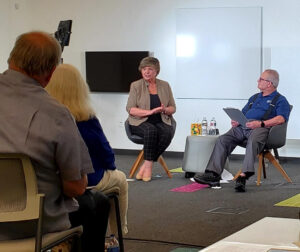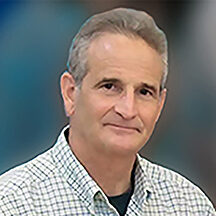Learning Community Goes Hybrid
We couldn’t have been more pleased with our 104th Non-Profit Empowerment Series Webinar on
Communicating with Donors, featuring Kelli Newman, APR, President of Newman & Newman, Inc., a nationally respected communication strategies firm. For the first time, we went hybrid, connecting the energy of a live audience to a much larger Zoom audience of non-profit leaders from across the country. Kelli was a treasure chest of experience, wisdom and insights on how non-profits of all different sizes and sectors can get the most return on their investments in communications, marketing, PR and branding. Our gratitude as well to local non-profit leaders who added their rich perspectives at the Texas A&M University-San Antonio TV studio. Of course, special thanks to Communications Professor Jenny Moore and Founding Director of Jaguar Student Media and her crackerjack production team of communications majors. Next up: Hybrid webinar on Wednesday, August 2nd, 4 to 5 p.m., Central time on “What Do Foundations Want?” featuring Cody Knowlton, President and CEO, Baptist Health Foundation of San Antonio. You can register here.
Wonder Woman 2.0

Billionaire philanthropist MacKenzie Scott’s first open call for grants yielded 6,353 applications from nonprofits — meaning candidates have at least a 4% chance of being selected for a $1 million grant. Lever for Change, the non-profit overseeing the application process, said that the applications came from all 50 states, Puerto Rico and the U.S. Virgin Islands. The 250 winners will be announced in early 2024. Scott has shaken up philanthropic giving since 2019, dropping large, unrestricted and unexpected donations on non-profits when she began giving away the fortune she came into after divorcing Amazon founder Jeff Bezos. She has donated more than $14 billion in unrestricted funds to 1,600 nonprofit organizations. Scott is currently worth more than $36 billion.
Advancement Profession

The Washburn & McGoldrick 2023 survey of professionals is the 9th in their Advancement Moving Forward series. As the nation’s independent schools, colleges and universities prepare to welcome students to campus for the Fall, a new survey finds rising concerns among these institutions’ advancement leaders in their ability to achieve their financial goals for fiscal year. It finds that while a majority of educational chief advancement officers (78%) and their senior managers (66%) are confident they will achieve their fiscal year goals, there is significant concern among the resource development group regarding the impact that the economy will have on their outreach among donors. In fact, among the resource development group, 69% note an increase in prospects/donors concerns about the economy in their conversations with them as potentially impacting their support for educational institutions compared to 26% who have not seen any change in concerns about the economy. Other highlights:
- Staffing issues remain a top concern for advancement professionals. Currently, 52% responded that staff shortages and resignations will be a major challenge going forward.
- Hybrid work settings have become the norm for advancement professionals. The survey finds that (67%) of respondents are in a hybrid work schedule, the highest level yet recorded.
- There has been a sustained return to in-person (64%) and solicitation (77%) meetings by advancement professionals as they continue to shift away from remote engagement such as phone or video conferencing.
How Much is a Major Gift?

Ask 10 different experts and you’ll likely get 10 different responses. And that makes sense. Major gifts have different meanings to different organizations depending on their size, maturity and external factors. This is a common denominator: In every non-profit they are game changers and elevate the potential to champion the mission in touching, improving and saving more lives. Our thanks to Major Gifts Ramp-Up for featuring our blog on the subject. Read it and let us know your thinking on the amount of a major gift.
Research Diva

Penelope Burke understands donors and what they want more deeply than just about anyone in fundraising. In the last 20 years, she and her innovative firm, Cygnus Applied Research, Inc., have conducted surveys and research studies with more than a quarter-million donors. She has reached back into their lives to find out about the first time they gave, what motivates their philanthropy now, what their greatest and most frustrating experiences in giving are, and what their dreams are for their philanthropic future. Here are some of her latest nuggets:
- 90% of donors say thank-you letters are a really big deal. Be careful not to haul last year’s acknowledgement letter back into service. It deserves priority creativity and energy, and the payoff will be stronger renewal rates and rising average gift values.
- Too many donors aren’t opening your e-mails. Recognize and address the enormity of this challenge. A secret to open and read rates: Less is definitely more.
- Two out of 3 donors disappear after making only one modest gift to your non-profit. Address donor attrition by prioritizing your cause’s long-term vision.
- 55% of CEOs say the thing they dislike most about fundraising is getting the Board to do their part; 87% of board members agree they should be raising money, but most would rather drink hemlock. Note that one-size-fits-all doesn’t work for varying board personalities. Some are more suited for discovery, cultivation and stewardship, while only a few welcome solicitation.
Who Should Give?

A new poll of Americans finds that nearly half of those who stopped giving to charity over the past five years said they did so because they thought wealthier people could afford to give more — and should. Others said they simply could not afford to give. These findings by the Better Business Bureau’s Give.org, adds to research on the shrinking number of households that contribute to charity each year, dropping from 66% in 2000 to 49.6% in 2018. Middle- and upper-income Americans are especially likely to point toward super-wealthy donors for their decision not to donate. Other highlights:
- Older generations are more likely to have donated over the past five years, with 72% of respondents age 76 and above maintaining or increasing their contributions, compared with 67% of Boomers, 57% of Gen Xers, 57% of Millennials, and 42% of Gen Zers.
- Respondents who stopped contributing to charities were less likely than those who maintained their contributions to believe that donating to non-profits was more effective than shopping at socially responsible businesses, with only one in four saying that donating had a stronger impact. Among Gen Zers, 52% said shopping at responsible businesses had the same or greater impact.
Do a Little Good
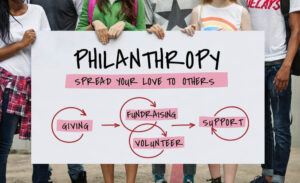
Anyone who has given a friend a ride, baked cookies for a sick family member, or even bought a stranger a cup of coffee knows acts of kindness can enhance happiness. But such random acts of kindness are still somewhat rare. University of Texas McCombs Marketing Professor Amit Kumar set out to discover why people don’t engage in pro-social acts — such as helping, sharing, or donating — more often. In a new study, Kumar, along with Nicholas Epley of the University of Chicago, found that people often underestimate how good these actions make recipients feel. Givers tend to focus on the object they’re providing or action they’re performing, while receivers instead concentrate on the feelings of warmth the act of kindness has conjured up. Givers’ “mis-calibrated expectations” — that receivers are solely concerned with the gift itself — can function as a barrier to performing more prosocial behaviors.
Advocacy Down

Independent Sector research shows that the number of U.S. non-profits engaging in advocacy or lobbying has declined by more than half since 2000. The report is based on surveys completed by 2,282 public charities designated as non-profits under the IRS 501(c)(3) and found that only 31% of non-profits engaged in advocacy or lobbying over the last five years, compared with 74% in 2000. Only 32% of non-profits were aware that federal rules permitted them to support or oppose federal legislation — a decline from 54% in 2000. Among organizations that engage in advocacy, 70% reported that such activities are expressly encouraged by the organization’s mission. More than half of respondents (56%) indicated that advocacy is not applicable to their mission, and 18% reported that their organization’s mission discourages advocacy.
High Tech or High Touch?

Yes, there are many potential applications for artificial intelligence in the sphere of fundraising and advancement. But there clearly are limitations, most prominently in the lucrative space of major gifts. Our thanks to Bloomerang for featuring our blog on this timely topic.
On Bookshelf: Camera Girl

Camera Girl brings to life Jackie’s years as a young, single woman trying to figure out who she wanted to become. Chafing at the expectations of her family and the societal limitations placed on women in that era, Jackie pursued her dream career as a writer. Set primarily during the years of 1949 to 1953, when Jackie was in her early twenties, the book recounts in heretofore unrevealed detail the story of her late college years and her early adulthood as a working woman. Before she met Jack Kennedy, Jacqueline Bouvier was the Washington Times-Herald’s “Inquiring Camera Girl,” posing compelling questions to members of the public on the streets of D.C. and snapping their photos with her unwieldy Graflex camera. She then fashioned the results into a daily column, of which 600 were published. Carl Sferrazza Anthony, a historian and leading expert on First Ladies, draws on these columns and previously unseen archives of Jackie’s writings from this time, along with insights gleaned from interviews he conducted with the former First Lady’s friends, colleagues, and family members. Camera Girl offers a fresh perspective on the woman later known as Jacqueline Kennedy and Jackie O, introducing us to the headstrong, self-assured young woman who went on to be one of the world’s most famous people.
The It Girl
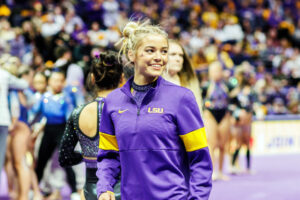
To be young, beautiful, rich and famous with a combined following of more than 13 million followers on TikTok, Instagram and Twitter. In her senior year at LSU, gymnast Olivia Dunne has now started a fund to help connect other female athletes at the school with name, image and likeness deals. She announced the launch of The Livvy Fund to help advance her business dealings and educate female athletes on marketing partnerships. The fund is working in partnership with Bayou Traditions, the official collective for LSU athletics. It is estimated that as much as 66% of the money raised by NIL collectives goes to male athletes. Dunne has the second-highest NIL valuation in the country at $3.5 million, only Bronny James at $6.7 million ranks ahead of her. The 20-year-old has endorsement deals with several high-profile companies, including Motorola, EA Sports and Body Armor. She was also featured in this year’s Sports Illustrated Swimsuit Issue.
Quiz: Volunteering by State
AmeriCorps, the federal agency for national service and volunteerism, has released its Volunteering and Civic Life in America research, the most comprehensive data on American volunteering and civic engagement assembled. Based on a survey conducted by AmeriCorps and the U.S. Census every other year, the research includes data on volunteering through organizations, informal helping and other civic behaviors. According to research, Americans contributed countless hours to their communities through formal and informal volunteerism between September 2020 and 2021 during the global pandemic. Nearly 51% of Americans, or 124.7 million people, informally helped their neighbors at least once in the past year. Additionally, more than 23% of Americans, or 60.7 million people, formally volunteered with an organization, giving more than 4.1 billion hours of service with an estimated economic value of $122.9 billion. Match the following states with their respective percentage of citizens performing volunteer service. Answers are shown at the bottom of the page.
1. Florida a. 23%
2. Massachusetts b. 28%
3. Nebraska c. 33%
4. Texas d. 40%
5. Utah e. 51%
Stratagems is published monthly by Jim Eskin, Founder of Eskin Fundraising Training, LLC. We offer workshops and customized training sessions for board members, staff and volunteers of non-profit organizations of all kinds and sizes. For details about our services and information, or to find out how to schedule a training session for your organization, visit our website. Follow our events on Facebook, and read more articles about philanthropy on our LinkedIn page.
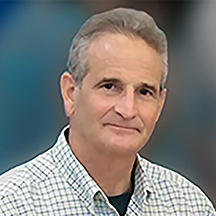
Jim Eskin, Founder
Eskin Fundraising Training
Email: [email protected]
Cell: 210.415.3748
www.eskinfundraisingtraining.com
ANSWERS TO THIS MONTH’S QUIZ: 1=a, 2=c, 3=d, 4=b, 5=e |

